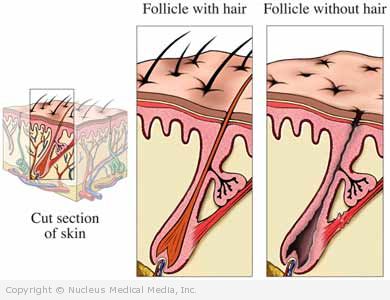Alopecia – Definition
Alopecia refers to hair loss in areas of skin that normally have hair. There are two forms of alopecia: scarring and non-scarring.
Scarring is the loss of hair follicles. This form causes permanent hair loss. The most prevalent forms of scarring alopecia are:
- Cutaneous lupus erythematous
- Central centrifugal cicatricial alopecia
- Fungal kerions
In the case of non-scarring, the hair shaft is gone, but the follicles are still present. It often is reversible. It can also develop into the scarring type. Non-scarring types include:
- Androgenetic (hereditary) alopecia
- Telogen effluvium
- Alopecia areata is an autoimmune process; the cause is not known
Alopecia – Causes
Many things can cause alopecia, including:
- Stress that prompts growing hairs to rest and shed
- Illness or surgery
- Vitamin and nutrient deficiencies
- Prolonged fever
- Childbirth
- Emotional/psychological stress
- Crash dieting
- Hormonal problems
- Overactive or underactive thyroid gland
- Medications
- Blood thinners
- Drugs for gout
- Chemotherapy for cancer treatment
- Vitamin A
- Birth control pills
- Antidepressants
- Blood pressure and heart medications
- Allergic reaction to medications
- Radiation therapy
- Infections
- Fungal infections
- Syphilis
- HIV
- Herpes simplex and zoster
- Autoimmune disorders
- Systemic and discoid lupus erythematosus
- Anemia
- Hair pulled too tightly by:
- Hair rollers
- Pigtails
- Cornrows
- Hot comb and oil treatments (can inflame the hair follicle and cause scarring)
- Twisting and pulling hair out due to psychiatric problems
- Genes
- Male and female-pattern baldness — usually inherited
- Congenital disorders — can include problems with the hair shaft
Alopecia – Risk Factors
Factors that increase your chance of alopecia include:
- Family history of baldness or hair loss
- Advancing age (for male and female-pattern baldness only)
- Pregnancy
- Stress
- Poor nutrition
Alopecia – Symptoms
Alopecia symptoms depend on the type of hair loss. Some of the more common symptoms include:
Male-pattern baldness:
- Hair recedes
- Hair falls out at the top of the head
- Affects men and women
Female-pattern baldness:
- Hair thins over the entire head
- Hair comes out when brushing
Alopecia areata:
- Rapid hair loss
- Round or oval patches of hair loss
- Sometimes tiny hairs are visible in the patches
- Fingernails and toenails with pits
Stress-related:
- Gradual shedding
- Hairs come out with gentle pulling
Fungal infections:
- Patches of hair loss
- Black dots in the patches
- Itching
- Scaling
- Inflammation (such as redness)
Alopecia – Diagnosis
The doctor will ask about your symptoms and medical history. A physical exam will be done. The doctor will examine the area(s) of hair loss, noting the pattern of hair loss and condition of the scalp.
This physical exam may include:
- Gentle pulling on the hair
- Taking samples of scalp areas with inflammation to examine under a microscope
- Analyzing samples of hair
- Checking for hair loss on other parts of the body
The doctor will ask questions about:
- Diet
- Hair care
- Medication use
- Your personal and family medical history
- Pregnancies, menopause, and monthly menstrual cycles
Other tests may include:
- Blood tests — to help identify underlying conditions that may be causing the hair loss
- Biopsy of the scalp — removal of a small tissue sample to be analyzed under the microscope
Alopecia – Treatment
Treatment will depend on the cause of the condition. Treatments include:
Medications
To treat related conditions:
- Drugs to correct a hormonal imbalance or deficiency
- Changing medication that may be causing the hair loss
- Antifungal shampoos and pills—to treat fungal infections
Direct treatment for baldness:
- For men — a prescription drug ( finasteride)
- Note: Pregnant women should not even handle this medication. Even a small amount absorbed through the skin of the hands can cause birth defects in baby boys.
- Over-the-counter medication ( minoxidil) — applied to the scalp daily (must be used on a regular basis)
- Note : If you have heart problems, discuss this drug with the doctor before using it.
- Steroid injection into your scalp — to help speed-up hair re-growth in alopecia areata
Alternative Treatments
- Topical immunotherapy — apply an allergen to scalp that causes local reaction like redness, itching and also induces hair growth; done if other efforts do not work
- Phototherapy — potential treatment for patients with alopecia areata; usually done over 4-6 months
Lifestyle Changes
Be gentle with your hair. Avoid pulling it tightly. If pulled over a long period of time, scarring can occur resulting in permanent hair loss.
If treatment does not correct the hair loss, you may opt for a wig, hairpiece, or hair weaving.
If emotional stress is the cause, learn and practice stress-management techniques.
Surgery
This can involve:
- Hair transplant — taking hair from the back and sides of the head and transplanting it in bald areas. As many as 300 grafts may be needed. You must return multiple times for the grafts.
- Scalp reduction with flaps — cutting the scalp and pulling the areas with hair closer together.
Chemotherapy Induced
- It could be minimal, moderate or severe.
- It is transient and completely reversible after chemotherapy is done.
- Currently, there are no medications available that were shown to reduce the risk of alopecia associated with cancer treatments.
Alopecia – Prevention
There are no prevention guidelines for the most common type of hair loss, male-pattern baldness. However, the following tips may help you avoid other types of hair loss:
- Do not pull your hair tightly into a ponytail, cornrows, or curlers.
- Learn and practice stress-management techniques.
- Obtain medical care for acute illnesses and to manage chronic conditions.
- Eat healthy, well-balanced meals.

